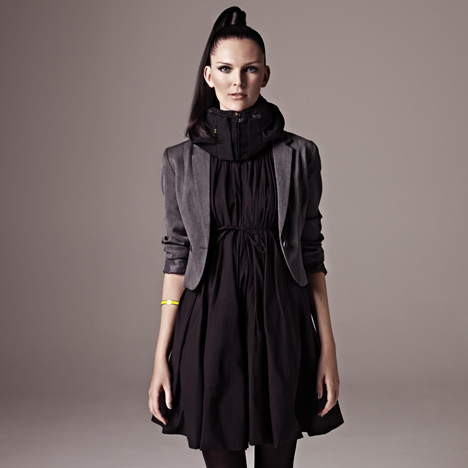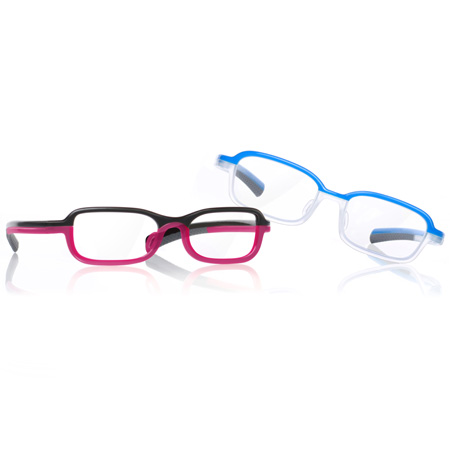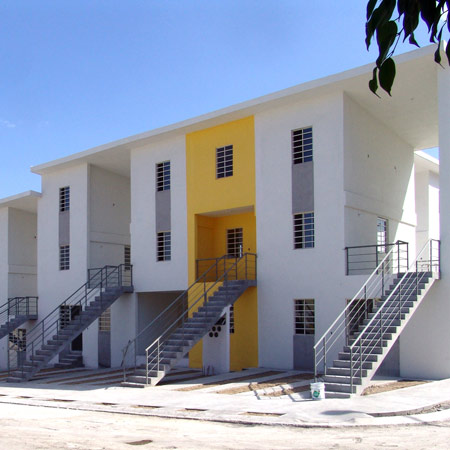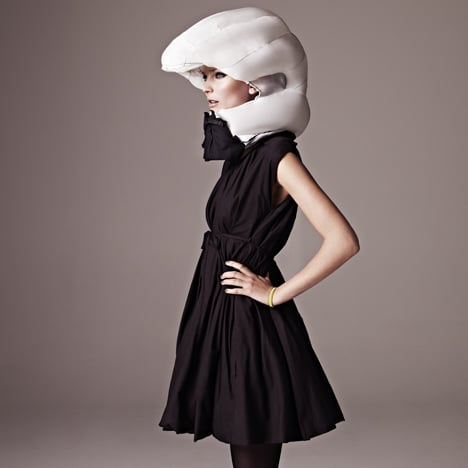Here are some images of the five winning projects at this year's INDEX: Awards, including Hövding, an inflatable bicycle helmet (above).

Designed by Anna Haupt and Terese Alstin, the helmet erupts from its hiding place inside a scarf when it senses abnormal movements. More details in our earlier story.

The winner in the Body category is See Better to Learn Better by fuseproject (above), a range of spectacles that are to be distributed free to children in Mexico.

Also in Mexico, a housing complex by Chilean architect Alejandro Aravena of Elemental (above, see our earlier story) where residents can add to their properties was awarded in the Home category.
The Community prize went to Design Seoul, a strategy to incorporate design thinking into every aspect of city development.
In the Work category, Indian project Design for Change was recognised for involving school children in the design of their own communities.
The Index: Award is the largest cash design prize in the world, worth €500,000.
The winners were announced at a ceremony in Copenhagen last night, as reported on Dezeen Wire. See our story about the 2009 winners here.
Here are some more details from the award organisers:
The winners of the world’s largest – and perhaps the most important – design award, the Danish INDEX: Award worth €500.000, were unveiled tonight on September 1st at a spectacular award ceremony in the Copenhagen Opera attended by HRH The Crown Prince and HRH The Crown Princess of Denmark along with 1,200 official guests from 48 countries.
The winners of INDEX: Award is not traditional design, but rather design that vastly improves the lives of people all over the world. The Danish, non-profit design organization INDEX: Design to Improve Life received almost 1,000 nominations for the competition from 78 countries and among these, the International INDEX: Jury initially selected 60 finalist designs, from which the five winners were announced tonight.
INDEX: Award is awarded in five categories: Body, Home, Work, Play and Community, and the five winners share a total purse of more than $800.000. INDEX: Award shows us how design can be a decisive factor when coming up with solutions for some of the world’s major challenges like climate changes, pollution, natural disasters, loneliness, elderly care, poverty, overconsumption and other important issues.
And the winners are:
In the Body Category, the winner is See Better to Learn Better (VerBien), which is a free eyeglasses program for Mexican children designed by former INDEX: Award winner Yves Behar (Switzerland). The glasses are free and custom made, designed for kids aged 6-18, and offers underprivileged children a luxury that usually is reserved for buyers of luxury brands – and most importantly the possibility to learn.
In some areas in Mexico, as many as 60% of all school children are in need of glasses, and 11% of all school children in the entire country are not learning anything, simply because they cannot see. Verbien is a solution for children in families that cannot afford neither the cost ofan eye exam nor the cost of the glasses themselves. In collaboration with the designers, the glasses manufacturer and the Mexican government, free eye exams are offered in schools, after when the children select and customize their own frames. The glasses are the produced locally, and in no time at all the children receive their new glasses free of charge, courtesy o fthe Mexican government – and thus receive the opportunity to read, learn and play.
More than 100,000 glasses have been distributed already throughout Mexico, and 400,000 more are expected to be distributed every year from now on.
“The whole program for a child to get a pair of glasses - with the eye exam, the making of custom lenses, custom frames, the assembly, putting in a carrying box and shipping to the child cost only $10! So it is pretty obvious for the Mexican government to invest that little in their student population and this way to secure the children an education, a better selfhelped future and increased job opportunities”, says Yves Behar.
In the Home Category, the winner is ELEMENTAL Monterrey – a revolutionary new model for social housing, also in Mexico. The dominant standard within social housing is to spend 2/3 of the total budget on building the houses and 1/3 on buying the land to build on. This means poor and undesirable location, a long and expensive commute and high likelihood of creating ghettoes.
In the Mexican city of Monterrey, Chilean architect Alejandro Aravena has turned the traditional approach to social housing upside down and spent 80% of the total budget on buying land in nice middle class areas and only 20% on building the actual houses. And the solution is a ingenious as it is simple: Only half the houses in Elemental Monterrey are not built, but only roofed.
The half that is actually built contains the essentials – all the things you cannot build yourself – namely the foundation, electrical installations, plumbing and walls, and the rest of the house is not built, but is a roofed patio (framed void) that can be filled by the owners according to their own specific needs, capabilities and preferences.
A solution that makes it possible to invest public money in desirable building plots, which could silence the existing criticism of social housing - especially the uniform solutions that are not capable of accommodating the diversity of needs, preferences and expectations that people have.
In the Work Category, the winner is Design for Change from India – a design based school competition designed to give children an opportunity to express their own ideas for a better world and put them into action.
Design for Change is a worldwide movement of young people who want to improve the state of the world, and more than 300,000 schools in more than 30 countries have already been involved in 2011. The competition communicates a very important understanding to children all over the world, namely: “I can. I can be the necessary change. I am useful. I can change.
”Based on remarkable results from Riverside School in India – and now distributed to the whole world – Design for Change aims to make children more competent and less helpless. And solid data shows that it is working: Design for change kids not only do well – they do best.
Through the Design for Change program, school children are directly involved in designing and implementing changes in their local communities, and in every individual case the children surprise and inspire their teachers, parents and everyone else by dreaming up and implementing good ideas to improve their world. From challenging age-old superstitions in rural communities and earning their own money to financing school computers or solving the problem of heavy school bags – children are proving that they have what it takes to design the future that they desire.
In the Play Category, the winner is Swedish Hövding – an invisible airbag for cyclists’ heads, shaped as a collar worn around the neck.
Every year, 30,000 people are injured or die in bicycle related accidents - in Sweden alone. And many of these accidents would have far less serious outcomes, if the bicyclists had beenwearing a helmet. But according to a Swedish survey, less than 30% of all bicyclists wearhelmets – mainly due to the fact that they do not want to mess up their hair, or because they cannot fit a warm hat underneath the helmet.
Thousands and thousands of bike helmets have been designed: Racing helmets, hat helmets, cap helmets, fun helmets. But they all have the same problem: They ruin your hair and do not warm your ears. Hövding changes the concept radically. Not by re-designing the helmet, but by designing something radically different: An invisible airbag that is worn as a collar and inflates only ifyou have an accident.
Hövding is ergonomic, subtle, practical, meets all safety requirements and matches your outfit because it looks like an ordinary scarf.
In the Community Category, the winner is Design Seoul - the first ever coherent designbased approach to improve life for citizens in a very large city.
The city of Seoul is very big and is home to more than 10 million people, but this was not always the case: During the Korean War, the city was left almost deserted after the countless bombings. But Seoul rose again and became an important part of what is known as The Miracle on the Han River, where Korea moved from having a GDP the size of Ghana’s to being the 15th richest country in the world.
In the years after the Korean War, Seoul rapidly grew wide and tall, and most emphasis was put on securing a roof over people’s heads as well as jobs and basic care. Therefore, there was not a lot of extra focus on beauty, citizen involvement or quality of life, but this is now changing.
Via a design based strategy of Design Seoul, the municipality of Seoul has thus implemented design thinking into the core of the city’s development, and has on the basis of this created numerous fantastic places to meet and live for the citizens of Seoul – as well as solving manysocial, environmental and health related issues in the process.
What is INDEX:?
INDEX: is a Danish-based, non-profit organization that was established in 2002 and coined the concept “Design to Improve Life”. INDEX: works globally to promote and apply both design and design processes that have the capacity to improve the lives of people worldwide.
INDEX: is widely recognized for its global biennial design award, INDEX: Award. It is the largest cash design prize in the world, worth €500,000, and it spans the five categories ofINDEX: Body, Home, Work, Play and Community. The categories cover human life from the near and concrete (body) to the common and general (community). The five categories are neither static nor definitive, and many designs combine and touch upon practices andexperiences from more than one category.
Nominating for INDEX: Award is completely free of charge, and nominations come from all over the world - more than 2,500 projects - have been nominated since the first award in 2005. The finalists are chosen by the outstanding international INDEX: Jury, who also selects the five winners.
INDEX: challenges the traditional concepts and stereotypes of design while highlighting the complexity of the design field, demonstrating very different solutions to problems such as HIV/AIDS, scarcity of potable water and carbon emissions.
INDEX: inspires, collects, advocates, communicates, evaluates, connects and discusses Design to Improve Life on a global scale.
What is Design to Improve Life?
INDEX: perceives design as it has been expressed by Professor John Heskett: “Design is the human capacity to shape and make our environments in ways that satisfy our needs and give meaning to our lives.” This basically means that everybody designs every day. Some of us choose to become professional designers, but the bottom line is that we all have the ability to design.
Design to Improve Life is design that is rated not only on its aesthetic values, but also on the scale of its positive impact on the world. It is judged on its economic, social and environmental sustainability, and at the same time on how it works in the cultural and geographical context it is intended for.
All this is perfectly aligned with the INDEX: set of evaluation criteria: Form, Impact and Context. Form is concerned with color, material, aesthetics, surfaces – it is what you can touch and feel. Form is what has traditionally been perceived as Design. Impact is about the positive effect of a design. How it addresses a challenge, how it improves life, possible distribution of it, its relevance and the economic and environmental sustainability of the design. Impact, in short, is about how a design improves life. Context is about the setting in which a design isproposed to function. It is about how a design fits the culture, geography, ethics and society in which it’s intended to be used. It is about Life.
Together, Form, impact and Context become “Design to Improve Life.”

